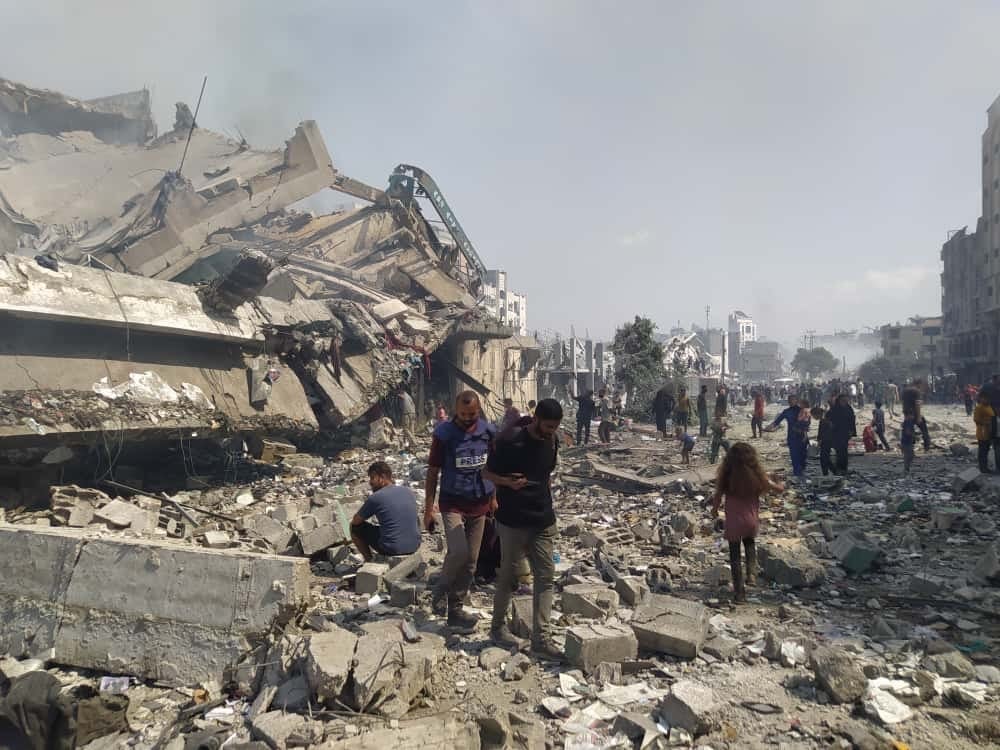Reportage
Bulldozers are paving over the ruins of Gaza with the bodies still inside
A new shipment of Caterpillar D9 armored bulldozers, delivered by the United States, has already entered Gaza. They stand ready to level the rubble.

Small white shrouds covering the bodies of children are everywhere in the photos and videos from Gaza City. Of entire families, only a few survivors remain, left to wander among the disfigured faces of the dead, caressing and kissing the lifeless bodies of their loved ones. One video, filmed after a bombing, shows a father from Gaza pressing his ear to the rubble, hoping to hear his children’s voices.
He calls their names: “Sama, my daughter! Saed, my son! I can’t hear you.” He crawls as far as he can under the chunks of concrete and the iron rebar jutting from the pillars. “My children! My son!” As he tries to claw his way through the debris, he reproaches his son through tears: “Saed, didn’t I tell you to look after your sister?”
Dozens of people remain missing under the collapsed houses, which had provided shelter to many displaced families. Israel wants to turn Gaza City into a desert, and it will do so at any cost. A new shipment of Caterpillar D9 armored bulldozers, delivered by the United States, has already entered Gaza. They stand ready to level the rubble, making it forever impossible to recover the bodies and give an accurate count of the dead. Before the latest operation, many had moved west to the al-Shati refugee camp, hoping to one day return to their homes. Now, it is precisely there that Tel Aviv has intensified its attacks.
Ali Tayeh is an artist from Gaza City. He has been displaced several times with his wife Israa, also a painter, and their two-year-old daughter Misk. He had managed to return to his home, although it had been damaged, but when Tel Aviv launched its ground operation, they fled under a hail of gunfire. “Israel is blowing up large residential blocks with unprecedented intensity and a total lack of media coverage. The house right next to ours was completely destroyed,” he told us as he and his family made their way to al-Shati on the coast. He went back into the city only to retrieve what he could before moving on again. “I managed to survive, to escape the bombs and the gunfire, but I’m going south because it’s a catastrophe here.”
The journey is extremely expensive and transport is scarce. Ali found a pickup truck for his family, but with no maintenance or spare parts available, the vehicle broke down, delaying them for a day. Eventually, they reached the Maghazi refugee camp in the central part of the Strip.
“It’s quiet here. Finally, we don’t hear the incessant noise of planes and gunfire. We haven’t slept for days and have spent the nights trying to calm our terrified daughter,” he told us. They don’t know if they’ll be able to stay in Maghazi or if they will be forced to move again, toward the crowded Mawasi area.
Meanwhile, those with no money or transportation have no choice but to remain in the urban area despite the evacuation order. “Every day, they’re killing us to force us to move south,” one witness told a journalist. “But we don’t have the money for it. All I have are the clothes I’m wearing.”
The hospitals cannot cope with the sheer number of wounded. Dr. Saya Aziz, an Australian anesthetist at al-Shifa Hospital, reported that as the bombings become more devastating, the number of amputations is rising, and waiting rooms are filling up with people with missing or dangling limbs. The doctor told Al-Jazeera that the operating room is full of flies and that they lack even the basic fluids to clean patients of blood and dust. The director of al-Shifa, Dr. Mohammad Abu Salmiya, said that available medical resources only cover less than 1% of the hospital’s needs. Overcrowded and without fuel or medicine, the hospitals in the Strip are close to shutting down.
In Gaza City on Tuesday, the Israeli army stormed the Jordanian field hospital and damaged the oxygen plant at al-Quds Hospital. The remaining oxygen tanks will last for only three days. The lack of food and medicine due to the Israeli blockade has caused the deaths of three more children at Nasser Hospital in Khan Younis.
Originally published at https://ilmanifesto.it/gaza-i-bulldozer-spianano-le-rovine-e-la-speranza-di-recuperare-i-corpi on 2025-09-24
